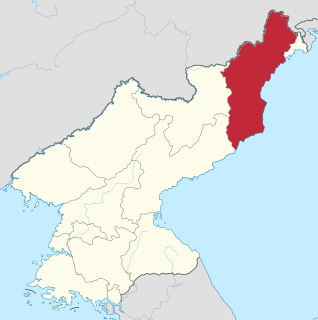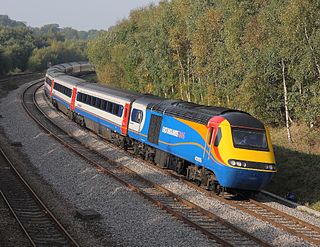
The Midland Main Line is a major railway line in England from London to Sheffield in the north of England. The line is under the Network Rail description of Route 19; it comprises the lines from London's St Pancras station via Leicester, Derby/Nottingham and Chesterfield in the East Midlands.
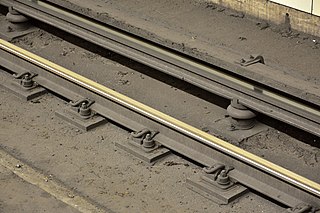
A third rail is a method of providing electric power to a railway locomotive or train, through a semi-continuous rigid conductor placed alongside or between the rails of a railway track. It is used typically in a mass transit or rapid transit system, which has alignments in its own corridors, fully or almost fully segregated from the outside environment. Third rail systems are always supplied from direct current electricity.

An electric locomotive is a locomotive powered by electricity from overhead lines, a third rail or on-board energy storage such as a battery or a supercapacitor.

The East Coast Railway is one of the 18 railway zones of Indian Railways. It came into existence on 1 April 2003. As the name suggests, most of the railway routes of the zone are near the east coast of India. The headquarters of the zone are at Bhubaneswar.

A railway electrification system supplies electric power to railway trains and trams without an on-board prime mover or local fuel supply. Electric railways use electric locomotives to haul passengers or freight in separate cars or electric multiple units, passenger cars with their own motors. Electricity is typically generated in large and relatively efficient generating stations, transmitted to the railway network and distributed to the trains. Some electric railways have their own dedicated generating stations and transmission lines but most purchase power from an electric utility. The railway usually provides its own distribution lines, switches and transformers.

The Sunbury railway line is a suburban electric railway in Melbourne, Australia. It has 15 stations, in Myki ticketing Zones 1 and 2. It is the electrified section of the Bendigo railway within metropolitan Melbourne. Prior to the line extension to Sunbury, the line was known as the Sydenham railway line, and prior to the extension of electrification to Sydenham, the line was known as the St Albans railway line.

The North Wales Coast Line, also known as the North Wales Main Line, is the railway line from Crewe to Holyhead. Virgin Trains consider their services along it to be a spur of the West Coast Main Line.

The Chase Line is a suburban railway line in the West Midlands region of England. It runs from its southern terminus, Birmingham New Street, to Walsall, and then Rugeley in Staffordshire, where it joins the Trent Valley Line. The name of the line refers to Cannock Chase which it runs through at its northern end.
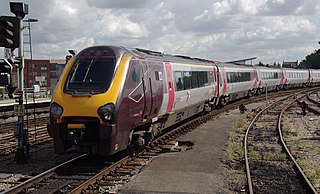
The Cross Country Route is a long-distance UK rail route that has in its central part superseded the Midland Railway. It runs from Cornwall via Bristol, Birmingham, Derby, Sheffield and Leeds and the north east to Scotland. It facilitates some of the longest passenger journeys in the UK such as Aberdeen to Penzance. In the summer services are provided to additional coastal stations such as Newquay.
Railway electrification systems using alternating current (AC) at 25 kilovolts (kV) are used worldwide, especially for high-speed rail.
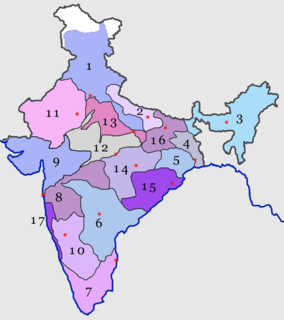
The Eastern Railway is among the 18 zones of the Indian Railways. Its headquarters is at Fairley Place, Kolkata and comprises four divisions: Howrah, Malda, Sealdah, and Asansol. Each division is headed by a Divisional Railway Manager (DRM). The name of the division denotes the name of the city where the divisional headquarters is located. Eastern Railway Consists Most no. of A1 and A Category Stations like Howrah, Sealdah, Bhagalpur, Asansol, Durgapur etc. Eastern Railways operates one of the oldest trains of India, Kalka Mail. 3 Popular Zones ECR, SER NFR were part of ER before.

The South Wales Main Line, originally known as the London, Bristol and South Wales Direct Railway or simply as the Bristol and South Wales Direct Railway, is a branch of the Great Western Main Line in Great Britain. It diverges from the core London-Bristol line at Royal Wootton Bassett near Swindon, first calling at Bristol Parkway, after which the line continues through the Severn Tunnel into South Wales.

Railway electrification in Great Britain began during the late 19th century. A range of voltages has been used, employing both overhead lines and conductor rails; the two most common systems are 25 kV AC using overhead lines and the 750 V DC third rail system used in southeast England and on Merseyrail. In 2006, 40%—3,062 miles (4,928 km) of the British rail network was electrified, and 60% of all rail journeys were by electric traction.

The Norwegian railway network consists of 2,552 kilometers (1,586 mi) of electrified railway lines, constituting 62% of the Norwegian National Rail Administration's 4,114 kilometers (2,556 mi) of line. The first three mainline systems to be electrified were private ore-hauling lines. The Thamshavn Line opened in 1909, and remained in revenue use until 1973, after which it was converted to a heritage railway. It is the world's oldest remaining alternating-current railway and the only narrow gauge railway in the country to have been electrified. It was followed by Norsk Transport's Rjukan and Tinnoset Lines two years later, and Sydvaranger's Kirkenes–Bjørnevatn Line in 1922. The Norwegian State Railways' (NSB) first electrification was parts of the Drammen Line in 1922 and the ore-hauling Ofoten Line in 1923, which connects to the Iron Ore Line in Sweden. The use of El 1 locomotives on the Drammen Line proved a large cost-saver over steam locomotives, and NSB started electrifying other lines around Oslo; from 1927 to 1930, the remainder of the Drammen Line, and the continuation along the Randsfjorden and Sørlandet Lines to Kongsvinger were converted, along with the first section of the Trunk Line. In 1935, the Hardanger Line became the first section of new NSB track to be electrified. From 1936 to 1940, NSB electrified the Østfold Line as well as more of the Sørland Line and the Bratsberg Line, connecting all electric lines west of Oslo.

The Andal–Sainthia branch line is a railway line connecting Andal on the Bardhaman–Asansol section of the Howrah–Delhi Main Line and Sainthia Junction on the Sahibganj Loop. This 73 kilometres (45 mi) track is under the jurisdiction of Eastern Railway. This track passes through the north-eastern part of the Raniganj Coalfield in Bardhaman district and the western part of Birbhum district in the Indian state of West Bengal.
The Sealdah–Hasnabad–Bongaon–Ranaghat line is a set of three lines interlinked with each other: the Sealdah-Bangaon line connecting Sealdah and Bangaon,the Barasat–Basirhat–Hasnabad line connecting Barasat and Hasnabad, and the Ranaghat–Bangaon line connecting Ranaghat and Bangaon. It is part of the Kolkata Suburban Railway system and is under the jurisdiction of Eastern Railway.
Jharia Coalfield has a series of railway lines covering the region lying between the Grand Chord line on the north and the Damodar in the south.
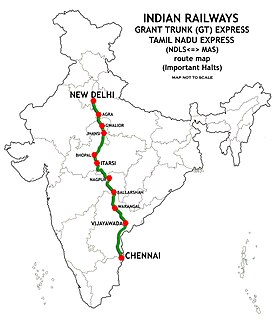
The Delhi–Nagpur–Chennai line is a railway line connecting Chennai and Delhi cutting across southern part of the Eastern Coastal Plains of India, the Eastern Ghats, the Deccan Plateau and the Yamuna valley. It covers a distance of 2,182 kilometres (1,356 mi) across Delhi, Haryana, Uttar Pradesh, Rajasthan, Madhya Pradesh, Maharashtra, Telangana, Andhra Pradesh and Tamil Nadu. The route is used by the Grand Trunk Express and as such is referred to by many as the Grand Trunk Route.

The Mumbai–Chennai line is a railway line connecting Chennai and Mumbai cutting across southern part of the Deccan Plateau. It covers a distance of 1,281 kilometres (796 mi) across Maharashtra, Karnataka, Telangana, Andhra Pradesh and Tamil Nadu.
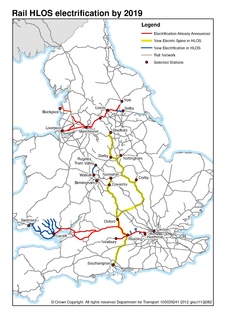
Proposed railway electrification in Great Britain. In 2009, Lord Adonis was appointed Secretary of State for Transport. After a gap of more than a decade, electrification was back on the agenda and Adonis announced plans to electrify the Great Western Main Line from London as far as Swansea, as well as infill electrification schemes in the North West of England. In July 2012 the UK government announced £4.2 billion of new electrification schemes, all at 25 kV AC and reconfirmed schemes previously announced by Adonis. These were to be Northern Hub, Great Western Main Line, South Wales Main Line, Midland Main Line, Electric Spine, Crossrail, Gospel Oak to Barking Line and West Midlands suburban lines including the Cross-City Line. Rail transport in Scotland is a devolved matter for the Scottish Government but they too have pursued electrification with multiple schemes in the Central Belt. All these have been 25 kV AC also as in England and Wales. Electrification has not been without controversy with cancellations and various appearances of the Secretary of State for Transport called before the Transport Select Committee.. A written question was submitted and answered in parliament regarding route miles electrified in the years 1997-2019. In March 2019 the Railway Industry Association published a paper on Electrification cost challenge suggesting ways forward and a rolling program of electrification.


